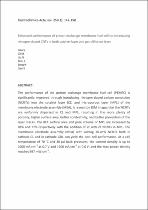 ResearchSpace
ResearchSpace
Enhanced performance of proton exchange membrane fuel cell by introducing nitrogen-doped CNTs in both catalyst layer and gas diffusion layer
JavaScript is disabled for your browser. Some features of this site may not work without it.
- ResearchSpace
- →
- Research Publications/Outputs
- →
- Journal Articles
- →
- View Item
| dc.contributor.author |
Hou, S

|
|
| dc.contributor.author |
Chi, B

|
|
| dc.contributor.author |
Liu, G

|
|
| dc.contributor.author |
Ren, Jianwei

|
|
| dc.contributor.author |
Song, H

|
|
| dc.contributor.author |
Liao, S

|
|
| dc.date.accessioned | 2018-01-09T07:17:13Z | |
| dc.date.available | 2018-01-09T07:17:13Z | |
| dc.date.issued | 2017-11 | |
| dc.identifier.citation | Hou, S. et al. 2017. Enhanced performance of proton exchange membrane fuel cell by introducing nitrogen-doped CNTs in both catalyst layer and gas diffusion layer. Electrochimica Acta, vol. 253(1): 142-150 | en_US |
| dc.identifier.issn | 0013-4686 | |
| dc.identifier.uri | http://www.sciencedirect.com/science/article/pii/S0013468617318200 | |
| dc.identifier.uri | https://doi.org/10.1016/j.electacta.2017.08.160 | |
| dc.identifier.uri | http://hdl.handle.net/10204/9943 | |
| dc.description | Copyright: 2017 Elsevier. Due to copyright restrictions, the attached PDF file only contains the abstract of the full text item. For access to the full text item, please consult the publisher's website. | en_US |
| dc.description.abstract | The performance of the proton exchange membrane fuel cell (PEMFC) is significantly improved through introducing nitrogen-doped carbon nanotubes (NCNTs) into the catalyst layer (CL) and microporous layer (MPL) of the membrane electrode assembly (MEA), it reveals by SEM images that the NCNTs are uniformly dispersed in CL and MPL, resulting in the more plenty of porosity, higher surface area, better conductivity, and better prevention of the layer cracks. The BET surface area and pore volume of MPL are increased by 88% and 77% respectively with the addition of 20 wt% of NCNTs in MPL. The membrane electrode assembly (MEA) with adding 20 wt% NCNTs both in cathode CL and in cathode GDL can yield the best cell performance. At a cell temperature of 70 °C and 30 psi back pressures, the current density is up to 1000 mA cm−2 at 0.7 V and 1600 mA cm−2 at 0.6 V, and the max power density reaches 997 mW cm−2. | en_US |
| dc.language.iso | en | en_US |
| dc.publisher | Elsevier | en_US |
| dc.relation.ispartofseries | Worklist;19532 | |
| dc.subject | Catalyst layer | en_US |
| dc.subject | Carbon nanotubes | en_US |
| dc.subject | Microporous layer | en_US |
| dc.subject | Nitrogen-doped | en_US |
| dc.subject | Proton exchange membrane fuel cell | en_US |
| dc.title | Enhanced performance of proton exchange membrane fuel cell by introducing nitrogen-doped CNTs in both catalyst layer and gas diffusion layer | en_US |
| dc.type | Article | en_US |
| dc.identifier.apacitation | Hou, S., Chi, B., Liu, G., Ren, J., Song, H., & Liao, S. (2017). Enhanced performance of proton exchange membrane fuel cell by introducing nitrogen-doped CNTs in both catalyst layer and gas diffusion layer. http://hdl.handle.net/10204/9943 | en_ZA |
| dc.identifier.chicagocitation | Hou, S, B Chi, G Liu, Jianwei Ren, H Song, and S Liao "Enhanced performance of proton exchange membrane fuel cell by introducing nitrogen-doped CNTs in both catalyst layer and gas diffusion layer." (2017) http://hdl.handle.net/10204/9943 | en_ZA |
| dc.identifier.vancouvercitation | Hou S, Chi B, Liu G, Ren J, Song H, Liao S. Enhanced performance of proton exchange membrane fuel cell by introducing nitrogen-doped CNTs in both catalyst layer and gas diffusion layer. 2017; http://hdl.handle.net/10204/9943. | en_ZA |
| dc.identifier.ris | TY - Article AU - Hou, S AU - Chi, B AU - Liu, G AU - Ren, Jianwei AU - Song, H AU - Liao, S AB - The performance of the proton exchange membrane fuel cell (PEMFC) is significantly improved through introducing nitrogen-doped carbon nanotubes (NCNTs) into the catalyst layer (CL) and microporous layer (MPL) of the membrane electrode assembly (MEA), it reveals by SEM images that the NCNTs are uniformly dispersed in CL and MPL, resulting in the more plenty of porosity, higher surface area, better conductivity, and better prevention of the layer cracks. The BET surface area and pore volume of MPL are increased by 88% and 77% respectively with the addition of 20 wt% of NCNTs in MPL. The membrane electrode assembly (MEA) with adding 20 wt% NCNTs both in cathode CL and in cathode GDL can yield the best cell performance. At a cell temperature of 70 °C and 30 psi back pressures, the current density is up to 1000 mA cm−2 at 0.7 V and 1600 mA cm−2 at 0.6 V, and the max power density reaches 997 mW cm−2. DA - 2017-11 DB - ResearchSpace DP - CSIR KW - Catalyst layer KW - Carbon nanotubes KW - Microporous layer KW - Nitrogen-doped KW - Proton exchange membrane fuel cell LK - https://researchspace.csir.co.za PY - 2017 SM - 0013-4686 T1 - Enhanced performance of proton exchange membrane fuel cell by introducing nitrogen-doped CNTs in both catalyst layer and gas diffusion layer TI - Enhanced performance of proton exchange membrane fuel cell by introducing nitrogen-doped CNTs in both catalyst layer and gas diffusion layer UR - http://hdl.handle.net/10204/9943 ER - | en_ZA |





